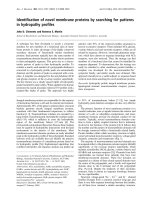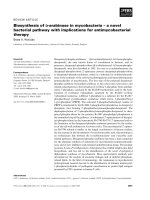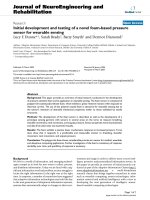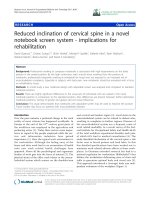Novel chiral stationary phases (CSP) for enantioseparation processes
Bạn đang xem bản rút gọn của tài liệu. Xem và tải ngay bản đầy đủ của tài liệu tại đây (20.53 MB, 233 trang )
NOVEL CHIRAL STATIONARY PHASES (CSP) FOR
ENANTIOSEPARATION PROCESSES
CHEN LEI
NATIONAL UNVIERSITY OF SINGAPORE
2002
ii
NOVEL CHIRAL STATIONARY PHASES (CSP) FOR
ENANTIOSEPARATION PROCESSES
CHEN LEI
(MSc)
A THESIS SUBMITTED FOR THE DEGREE OF
DOCTOR OF PHYLOSORPHY
DEPARTMENT OF CHEMISTRY
NATIONAL UNVIERSITY OF SINGAPORE
2003
iii
Acknowledgements
I wish to express my immense gratitude to my supervisor, Associate Professor
Ng Siu-Choon for his constant guidance, advice and encouragement throughout this
project. I would like to thank Professor Ching Chi Bun for his suggest and support in
the topic of this work.
My thanks to Dr. Zhou X. C., Dr. Bai Z. W., Fu P., Dr. Ong T. T., Zhang C. Y.,
Dr. Lu H. F., Wong Y. C., Ma Y. F. and all the members in functional polymer groups
for their kind support, particularly thanks to Dr. Zaher J. for the correction and
revision on the thesis.
I also would like to express my deepest gratitude to my family: my daughter-
Tian Tian, my parents, sister, husband, in-laws for their everlasting understanding
and support during the times in studying at the National University of Singapore.
Last but not least, I also want to thank National University of Singapore for
providing Research Scholarship and National Science Technology Board for the NSTB
top-up scholarship throughout the period of my candidature.
CONTENTS
Acknowledgements i
Summary v
Abbreviations and Symbols viii
Captions xi
Tables xiii
Chapter 1 Introduction 1
1.1 General background 2
1.2 Methods available for chiral discrimination 5
1.3 Chromatographic methods for chiral discrimination 7
1.3.1 Chiral stationary phases (CSPs) 8
I. Type I Donor-acceptor -Brush type (Pirkle) type phases 9
II Type II Cellulose derivatives 11
III Type III Chiral cavity phases 14
IV Type IV Ligand exchange columns 15
V Type V Protein phases 16
VI Macrocyclic Antibiotics 17
1.3.2 Chiral mobile phase additives (CMPA) 18
I Ion Pair additives 19
II Inclusion complexes 19
III Ligand exchange 19
IV Protein additives 20
1.4 Cyclodextrin and its applications 20
1.4.1 Structure and physical properties of cyclodextrins 21
1.4.2 Cyclodextrin-based chiral stationary phases (CD-CSPs) 25
1.4.3 Mechanism of separation 28
1.4.3.1 Multiple-interaction (multi-model) chiral bonded phases 28
1.4.3.2 Enantioseparation mechanism 29
1.5 Scope of project work 33
Chapter 2 Chiral Stationary Phases Derived from Mono-(6-
Azido-6-Deoxy)-Perfunctionalized-β-Cyclodextrins
via Single Urea Linkage with Silica Gel 35
2.1 Introduction 36
2.2 Syntheses 38
2.2.1 General overview 38
2.2.2 Staudinger reaction 42
ii
2.2.3 Preparations of HPLC columns 44
2.3 Characterizations 44
2.4 Enantioseparation abilities of the CSPs 48
2.4.1 Column efficiencies, theoretical heights of plates and surface
concentrations 48
2.4.2 Enantioseparation abilities of the HPLC columns 49
A. Simple racemic compounds 50
B. β-Adrenergic blocking agents 59
C. Atropine and scopolamine derivatives 67
D. Racemic primary, secondary and tertiary amines 72
E. Weak acids 74
F. Miscellaneous 76
2.4.3 Comparative study on chromatographic properties of SINU-NC
and CYCLOBOND I 2000 SN columns 77
Chapter 3 Chiral Stationary Phases Derived from Heptakis-(6-
Azido-6-Deoxy-2,3-Di-O-Functionalized)-β-
Cyclodextrins via Multiple Urea Linkages with Silica
Gel 83
3.1 Introduction 84
3.2 Syntheses 85
3.2.1 General overview 85
3.2.2 Preparations of the HPLC columns HEPT-PC and HEPT-NC 86
3.3 Characterizations 86
3.4 Enantioseparation abilities of the CSPs 90
3.4.1 Column efficiencies, theoretical heights of plates and surface
concentrations 90
3.4.2 Enantioseparation results on HEPT-PC and HEPT-NC 90
3.4.3 Stability of the columns under RP condition 97
3.4.4 Loading capacity of the HPLC column 98
Chapter 4 Chiral Stationary Phases Derived from Partial-6-(5-
Pent-1-Enylated)-Functionalized β-Cyclodextrins
Covalently Bonded to Silica Gel via an Ether linkage 99
4.1 Introduction 100
4.2 Syntheses 102
4.2.1 General overviews 102
4.2.2 Preparations of chiral HPLC columns 103
4.3 Characterizations 103
4.4 Enantioseparation results on ETHR-PC and ETHR-NC 105
iii
A. Substituted (1-aryl)ethanols 105
B. Racemic amines 108
C. β-Adrenergic blockers 109
D. Racemates with more than one optical center on ETHR-PC 112
E. Chiral phenyl dihydrotriazines 113
Chapter 5 Preparative HPLC Enantioseparations 117
5.1 Introduction 118
5.1.1 General strategy 119
5.1.2 Selection criteria for the CSPs 120
5.2 Scale up procedure and preparative analyses 122
5.3 Results and discussions 124
Chapter 6 Thermodynamic Studies 131
6.1 Introduction 132
6.2 Theory of calculation 133
6.3 Experimental 134
6.4 Results and discussions 135
6.4.1 Thermodynamic studies on SINU-PC and SINU-NC. 135
6.4.2 Thermodynamic studies on ETHR-PC 139
Chapter 7 Chromatographic Properties of Chiral Stationary
Phases and Optimizations of Enantioseparation
Conditions 141
7.1 Introduction 142
7.2 Interactions between CSPs and analytes 142
7.2.1 Substituents of the β-CD-based CSPs 148
7.2.2 Immobilization methods 149
7.2.3 Enantioseparated racemates 150
7.3 Optimization of enantioseparation conditions 152
7.3.1 Mobile phase effects 152
7.3.1.1 Polar modifiers 152
7.3.1.2 Solvents 155
7.3.1.3 Compositions of mobile phase 156
7.3.2 Effects of pH values and salt under RP mode 160
7.3.2.1 Buffer types 161
7.3.2.2 pH values of buffer 162
7.3.2.3 Concentrations of buffer 163
7.3.3 Effect of the flow rates of mobile phases 164
7.3.4 Influence of the silica gel 166
iv
Chapter 8 Experimental 171
8.1 Chemicals, materials and apparatus 172
8.2 Instrumentation for structural analysis and characterization 172
8.3 HPLC part 173
8.3.1 HPLC system 174
8.3.2 HPLC conditions 175
8.3.3 Packing Procedure for HPLC column 175
8.3.4 Preparation of mobile phases 176
8.3.5 Preparation of buffer solutions 176
8.3.6 Optical rotation 176
8.3.7 Calculation methods of chromatographic parameters and
equations 177
8.4 Syntheses of β-CD derivatives 179
8.4.1 Mono-(6-azido-6-deoxy)-β-CD derivatives 179
8.4.1.1 Mono-(6-(p-tosylsulphonyl)-6-deoxy)-β-CD (OTS-CD) 179
8.4.1.2 Mono-(6-azido-6-deoxy)-β-CD derivatives 180
8.4.2 Heptakis-(6-azido-6-deoxy)-β-CD derivatives 188
8.4.3 Partial-6-(5-pent-1-enylated)-β-CD derivatives 190
8.4.3.1 Partial-6-(5-pent-1-enylated) β-CD 190
8.4.3.2 Partial-6-(5-pent-1-enylated)-perfunctionalized-β-CDs 190
8.5 Preparation of chiral stationary phases (CSPs) 191
8.5.1 Amino-functionalized silica gel 191
8.5.2 Immobilization of β-CD derivatives onto silica gel 192
8.5.2.1 Immobilization of mono-(6-azido-6-deoxy)- functionalized β-CDs onto
amino-functionalized silica gel 192
8.5.2.2 Immobilization of heptakis-(6-azido-6-deoxy-2,3-di-O-phenyl/naphthyl
carbamoylated)-β-CD derivatives onto amino-functionalized silica gels 193
8.5.2.3 Immobilization of partial-6-(5-pent-1-enylated)-perphenyl/ pernaphthyl-
carbamoylated-β-CDs onto silica gel (ETHR-PC and ETHR-NC) 194
Chapter 9 Conclusions and Suggestions for Future Work 196
9.1 Conclusions 197
9.2 Suggestions for future work 197
References 199
List of Patents and Publications: 211
Appendix I. Structures of Commercial Drugs 214
v
Summary
This work is a study of the syntheses of HPLC chiral stationary phases (CSPs)
derived from perfunctionalized β-cyclodextrins (β-CDs), namely mono-(6-azido-6-
deoxy)-perfunctionalized-β-CDs (2.3a-h), heptakis-(6-azido-6-deoxy-2,3-di-O-
perfunctionalized)-β-CDs (3.3) and partial-6-(5-pent-1-enylated)-perfunctionalized-β-
CDs (4.2). Mono-(6-azido-6-deoxy)-perfunctionalized-β-CD-based CSPs (2.4) and
heptakis-(6-azido-6-deoxy-2,3-di-O-perfunctionalized)-β-CD-based CSPs (3.4) were
prepared by immobilizations of β-CD derivatives onto amino-functionalized silica gel
via single and multiple urea linkage(s), respectively, using the application of
Staudinger reaction. The CSPs (4.4) derived from partial-6-(5-pent-1-enylated)-β-CDs
were produced by hydrosilylation and immobilization via ether linkages to silica gel.
Structures of mono-azido-perfunctionalized-β-CDs and CSPs
(OR N
3
(OR)
14
)
6
2.3
O
SiO
2
O
O
O
NHCNH(CH
2
)
3
Si(OR
(OR)
14
)
6
2.4, 5.1
2.3/4a, g, h R= phenyl carbamate
2.3/4b R= naphthyl carbamate
2.3/4c R= acetyll
2.3/4d R= methyl
2.3/4e R= benzoyl
2.3/4f R= benzyl
5.1 R= phenyl carbamate
Mono-(6-azido-6-deoxy)-perfunctionalized-β-CDs can be synthesized in two
steps: first, monotosylated-cyclodextrin was converted into mono-azido-β-cyclodextrin
by the S
N
2 reaction, followed by perfunctionalization by reaction with phenyl
isocyanate, naphthyl isocyanate, acetic anhydride, benzyl bromide and benzoyl
chloride respectively.
vi
Heptakis-azido-β-cyclodextrin was firstly produced by reaction with iodine with
the help of PPh
3
, followed by the substitution by azido groups. After the
functionalization, the β-CD derivatives were converted to CSPs via multiple urea
linkages to silica gel. In syntheses of above two series of CSPs, the immobilization of
β-CD derivatives were effected in presence of PPh
3
and CO
2
via an application of the
Staudinger reaction.
Structures of heptakis-(6-azido-6-deoxy)-perphenylcarbamoylated-β-CDs and CSPs
(N
3
)
7
(OR)
7
7
(OR)
3.3
a: R= phenyl carbamate
b: R= naphthyl carbamate
HNCNH
HNCNH
Si(CH
2
)
3
HNCNH
(OR)
14
OO
x
y
SiO
2
O
O
O
O
Z
3.4
Partial-6-(5-pent-1-enylated) β-CD was prepared by reacting with the 1-pentene
bromide in the presence of sodium hydride. After functionalization, the β-CD
derivatives were hydrosilylated by triethoxylsilane followed by the immobilization
onto the surface of silica gel via stable ether covalent linkers.
Structures of partial- (5-pent-1-enylated)-perfunctionalized β-cyclodextrin and CSPs
( ) (RO O(CH
2
)
3
CH=CH
2
)
n
14
OR
7-n
4.2
a: R= phenyl carbamate
b: R= naphthyl carbamate
( ) (
RO O(CH
2
)
5
Si O
O
14
OR
7-n
SiO
2
O
4.4
vii
The enantioseparation abilities of these CSPs were evaluated using a wide
variety of racemic compounds and pharmaceutical drugs/intermediates including (1-
aryl)ethanols, β-blockers, amines, tropines and pyrimidines. Results indicated that
2.4a-c, 2.4g-h, 3.4, 4.4 and 5.1 exhibited good enantioseparation abilities under both
normal and/or reversed phases conditions.
2.4g-h and 5.1 were prepared by immobilization of 2.3a onto silica gels with
different particle sizes of 5µm, 3µm and 15-35 µm, respectively. The enantioseparation
results indicated that particle sizes and surface properties of silica gels play an
important role in their chromatographic properties. When applied in preparative scale,
5.1 proved to be effective in collecting the optical pure isomers of atropine,
propranolol, isoproterenol, alprenolol, bendroflumethiazide and O-acetyl propranolol
under reversed phases.
Thermodynamic studies showed that all the CSPs were effective within the
temperature ranges of 0 to 40°C. Enantioselectivity was enthalpy dominated where
there is no conformational transition of CSPs during this temperature range. In
reversed phase, the most suitable polar organic solvent is MeOH. The best pH value of
the buffer comprising triethylamine and acetic acid applied under the reversed phases
fall in range of 4.65-5.65. The optimized conditions of several isomers in terms of
resolution (Rs) were also obtained.
viii
Abbreviations and Symbols
α
Selectivity
β-CD
Beta-Cyclodextrin
[α]
D
Optical rotation
AA Acetic acid
CD Cyclodextrin
CE Capillary Electrophoresis
CH
3
CN Acetonitrile
CSP Chiral stationary phase
DMF Dimethyl formamide
FT-IR Fourier Transform Infrared Spectroscopy
GC Gas Chromatography
HPLC High performance liquid chromatography
IPA Isopropanol, (or 2-propanol)
k’ Capacity ratio
L Column length
MeOH Methanol
N
eff
Column efficiency: effective plate number
NMR Nuclear Magnetic Resonance
NP Normal phase
RP Reverse phase
Rs Resolution
t
0
Dead time (retention time of unretained solute)
TEA Triethylamine
TEAA Triethylammonium acetate
TEAP Triethylammonium phosphate
THF Tetrahydrofuran
t
R
Retention time of solute
ix
Name of derivatives of β-cyclodextrin:
OTS-CD
Mono-(6-(p-tosylsulphonyl)-6-deoxy)-β-cyclodextrin
AZIDOCD
Mono-(6-azido-6-deoxy)-β-cyclodextrin
AZIDOPHCD
Mono-(6-azido-6-deoxy)-perphenylcarbamoylated-β-cyclodextrin
AZIDONACD
Mono-(6-azido-6-deoxy)-pernaphthylcarbamoylated-β-cyclodextrin
AZIDOACECD
Mono-(6-azido-6-deoxy)-peracetylated-β-cyclodextrin
AZIDOMECD
Mono-(6-azido-6-deoxy)-permethylated-β-cyclodextrin
AZIDOBENCD
Mono-(6-azido-6-deoxy)-perbenzoylated-β-cyclodextrin
AZIDOBYLCD
Mono-(6-azido-6-deoxy)-perbenzylated-β-cyclodextrin
C=CPHCD Mono-(6-(10’-undecenylcarbamido)-6-deoxy)-perphenyl-
carbamoylated-β-cyclodextrin
C=CACECD
Mono-(6-(10’-undecenylcarbamido)-6-deoxy)-peracetylated-β-
cyclodextrin
C=CMECD
Mono-(6-(10’-undecenylcarbamido)-6-deoxy)-permethylated-β-
cyclodextrin
CH
3
PHCD
Mono-(6-decenylcarbamido-6-deoxy)-perphenylcarbamoylated-β-
cyclodextrin
CH
3
ACECD
Mono-(6-decanylcarbamido-6-deoxy)-peracetylated-β-cyclodextrin
CH
3
MECD
Mono-(6-decanylcarbamido-6-deoxy)-permethylated-β-
cyclodextrin
(C=C(CH
2
)
3
CD)
Partial-6-(5-pent-1-enylated)-β-cyclodextrin
(C=C(CH
2
)
3
PHCD)
Partial-6-(5-pent-1-enylated)-perphenylcarbamoylated-β-
cyclodextrin
(C=C(CH
2
)
3
NACD)
Partial-6-(5-pent-1-enylated)-pernaphthylcarbamoylated-β-
cyclodextrin
HydroPPHCD Hydrosilylated partial-6-(5-pent-1-enylated)-
perphenylcarbamoylated-β-cyclodextrin
HydroPNACD Hydrosilylated partial-6-(5-pent-1-enylated)-
perphenylcarbamoylated-β-cyclodextrin
7IODOCD
Heptakis-(6-iodo-6-deoxy)-β-cyclodextrin
7AZIDOCD
Heptakis-(6-azido-6-deoxy)-β-cyclodextrin
7PPHCD
Heptakis-(6-azido-6-deoxy-2,3-di-O-perphenylcarbamoylated)-β-
cyclodextrin
7PNACD
Heptakis-(6-azido-6-deoxy-2,3-di-O-naphthylcarbamoylated)-β-
cyclodextrin
x
Names of Chiral Stationary Phases (CSPs).
SINU-PC
Mono-(6-azido-6-deoxy)-perphenylcarbamoylated-β-cyclodextrin
immobilized on Hypersil 5µm silica gel
SINU-NC
Mono-(6-azido-6-deoxy)-pernaphthylcarbamoylated-β-cyclodextrin
immobilized on Hypersil 5µm silica gel
SINU-AC
Mono-(6-azido-6-deoxy)-peracetylated-β-cyclodextrin immobilized
on Hypersil 5µm silica gel
SINU-ME
Mono-(6-azido-6-deoxy)-permethylated-β-cyclodextrin
immobilized on Hypersil 5µm silica gel
SINU-BN
Mono-(6-azido-6-deoxy)-perbenzoylated-β-cyclodextrin
immobilized on Hypersil 5µm silica gel
SINU-BY
Mono-(6-azido-6-deoxy)-perbenzylated-β-cyclodextrin
immobilized on Hypersil 5µm silica gel
SINU-PC-BDS5
Mono-(6-azido-6-deoxy)-perphenylcarbamoylated-β-cyclodextrin
immobilized on Hypersil BDS-5µm silica gel
SINU-PC-BDS3
Mono-(6-azido-6-deoxy)-perphenylcarbamoylated-β-cyclodextrin
immobilized on Hypersil BDS-3µm silica gel
PREP-SINU-PC
Mono-(6-azido-6-deoxy)-perphenylcarbamoylated-β-cyclodextrin
immobilized on Kieselgel 100 silica gel
HEPT-PC
Heptakis-(6-azido-6-deoxy-2,3-di-O-perphenylcarbamoylated)-β-
cyclodextrin immobilized on Hypersil 5 µm silica gel
HEPT-NC
Heptakis-(6-azido-6-deoxy-2,3-di-O-pernaphthylcarbamoylated)-β-
cyclodextrin immobilized on Hypersil 5 µm silica gel
ETHR-PC
Partial-6-(5-pent-1-enylated)-perphenylcarbamoylated-β-
cyclodextrin immobilized on Hypersil 5 µm silica gel
ETHR-NC
Partial-6-(5-pent-1-enylated)-pernaphthylcarbamoylated-β-
cyclodextrin immobilized on Hypersil 5 µm silica gel
xi
Captions
Figure 1.1 Stereochemical structures of one pair of enantiomers 2
Figure 1.2a) Structure of Pioglitazone 3
Figure 1.2b) Structure of troglitazone (Rezulin) 4
Figure 1.3 Stereochemical structure of thalidomide 4
Figure 1.4 Structure of Pirkle-type CSP 10
Figure 1.5 Basic unit of cellulose type phase 12
Figure 1.6 Ligand exchange type phases 15
Figure 1.7 Diagram of human alpha-acid glycoprotein 16
Figure 1.8a) Structure of β-cyclodextrin molecule 23
Figure 1.8b) Diagrammatic representation of β-cyclodextrin molecule 23
Figure 1.9 Post-immobilization derivatization of cyclodextrin 27
Figure 1.10 Three-point interaction model of CSPs in HPLC 30
Figure 1.11 Formation of reversible inclusion complex 31
Figure 2.1 Formation of stable urea linkage through Staudinger reaction 42
Figure 2.2 Possible mechanism of the immobilization 43
Figure 2.3 FT-IR spectra of the CSPs 46
Figure 2.4 Substituted (1-aryl)ethanols with different substituents at the para position
of aromatic ring 57
Figure 2.5 Typical structure of β-blockers 60
Figure 2.6 Chromatogram of alprenolol on SINU-PC. 63
Figure 2.7 Chromatograms of labetalol and nadolol on SINU-PC-BDS3 and SINU-PC-
BDS5. 65
Figure 2.8 Enantioseparations of propranolol on SINU-PC-BDS3 and SINU-PC-
BDS5. 66
Figure 2.9 Typical structures for atropines and scopolamines 68
Figure 2.10 Chromatograms for enantioseparation of TCPA, TCPG, NCPA and NCPG
on HEPT-PC. 70
Figure 2.11 Structural transforming of benzoin in acidic media 74
Figure 2.12 Chromatogram of bendroflumethiazide. 75
Figure 2.13 Diagrammatic difference in SINU-NC and CYCLOBOND I 2000 SN 77
Figure 3.1 MALDI-MS spectra of heptakis-(6-azido-6-deoxy-2,3-di-O-
phenylcarbamoylated)-β-CD. (C
140
H
133
O
42
N
35
, M = 2977.80 Da) 88
Figure 3.2 Chromatograms for 1-(4-chlorophenyl)- and 1-(4-bromophenyl)ethanol
under both NP and RP 91
Figure 3.3 Enantioseparation of propranolol under both NP and RP on HEPT-PC 94
Figure 3.4 Enantioseparation of bendroflumethiazide under both NP and RP 95
Figure 3.5 Representative chromatogram of enantioseparation of atropine. 97
Figure 3.6 Chromatograms for enantioseparations of TCPP and NCPA on HEPT-PC 97
xii
Figure 4.1 Chromatograms of labetolol and nadolol on ETHR-NC 111
Figure 4.2 Chromatogram of 2-(phenyl-phenylamino-methyl)-cyclopentanone 112
Figure 4.3 Basic structure of chiral phenyl dihydrotriazines. 114
Figure 5.1 General strategy for preparative enantioseparation 119
Figure 5.2 Chromatograms of atropine using the different injection amounts on PREP-
SINU-PC. 127
Figure 5.3 Effects of the loading amount on k′, α and Rs on PREP-SINU-PC 128
Figure 6.1 Effect of temperature on k’ and α of 1-(3-hydroxyphenyl)ethanol 135
Figure 6.2 Van’t Hoff curves for k’ and α of 1-(3-hydroxyphenyl)ethanol on SINU-
PC 137
Figure 6.3 Van’t Hoff plots for k’ and α of brompheniramine on SINU-NC. 137
Figure 6.4 Enthalpy-entropy compensation for brompheniramine on SINU-PC with n-
hexane/IPA as the mobile phase. 138
Figure 6.5 Effect of temperature on k’ and α of 1-(4-bromophenyl)ethanol on ETHR-
PC 139
Figure 6.6 Van’t Hoff curves for k’ and α of 1-(4-bromophenyl)ethanol on ETHR-PC. 139
Figure 6.7 Enthalpy-entropy compensation for 1-(4-bromophenyl)ethanol on ETHR-
PC with n-hexane/IPA as the mobile phase 140
Figure 7.1 Interaction sites in mono-(6-azido-6-deoxy)-pernaphthylcarbamoylated-β-
CD 145
Figure 7.2 Retentions of aromatic compounds on SINU-NC 147
Figure 7.3 Enantioseparations of M-NT in MeOH (or CH
3
CN)/ buffer on ETHR-NC 153
Figure 7.4a-b) Influence of the IPA proportion on k’ and α for each enantiomer on SINU-
PC 154
Figure 7.4c-d) Influence of CH
3
CN proportion in RP on k’ and α for each enantiomer on
SINU-PC. 154
Figure 7.5a) Effects of2-propanol content on k′, α and Rs for metoprolol in NP 157
Figure 7.5b) Effects of IPA content on k′, α and Rs for 1-(4-bromophenyl)ethanol in NP 157
Figure 7.5c) Effects of CH
3
CN content on k′, α and Rs for bendroflumethiazide in RP 159
Figure 7.5d) Effects of CH
3
CN content on k′, α and Rs for M-NT in RP 159
Figure 7.6 Effects of bufferusing M-NT as analyte 161
Figure 7.7a) Effect of pH on k’, α and Rs for O-Br 162
Figure 7.7b) Effect of pH on k’, α and Rs for M-NT 163
Figure 7.8 Effect of concentration of TEAA on k', α and Rs of P-OM 164
Figure 7.9 Influence of flow rate on retentions, selectivity and resolutions of O-Br 165
Figure 7.10a) SEMs for Ggel silica gel with irregular shapes. (Particle size is 5µm.) 168
Figure 7.10b) SEMs for Hypersil silica gel with spherical shapes. (Particle size is 5µm.) 168
Figure 8.1 An example of a chromatogram 177
xiii
Tables
Table 1.1 Examples of pharmaceutical products and food additives which show the
effect of chirality 5
Table 1.2 Classification of chiral stationary phases 9
Table 1.3 Recent developed Pirkle-type CSPs 11
Table 1.4 Four series of columns developed by Daicel Chemical Industries, Ltd 13
Table 1.5 The types, structures and applications of cellulose and amylose-based
Daicel columns 13
Table 1.6 Structures and applications of Ticoplanin and Vancomycin 18
Table 1.7 Physical properties of α, β and γ-cyclodextrin 22
Table 2.1 Mono-(6-azido-6-deoxy)-perfunctionalised cyclodextrins 45
Table 2.2 Mono-(6-decanyl-6-deoxy)- or mono- (6-(10’-undecenylcarbamido)-6-
deoxy)-perfunctionalised cyclodextrins 45
Table 2.3 Elemental analyses and surface concentrations of the CSPs 47
Table 2.4 Column efficiencies, theoretical heights of plates and surface
concentrations for HPLC columns 49
Table 2.5 Enantioseparations of substituted (1-aryl)ethanols on SINU-PC and SINU-
NC 52
Table 2.6 Enantioseparations of substituted (1-aryl)ethanols on SINU-ME. 53
Table 2.7 Enantioseparations of (1-aryl)ethanols on SINU-PC-BDS3 and SINU-PC-
BDS5. 55
Table 2.8 Enantioseparations of 1-(4-bromophenyl)ethanol and 1-(4-
chlorophenyl)ethanol on SINU-PC-BDS3 and SINU-PC-BDS5. 58
Table 2.9 Enantioseparations of β-blocking agents on SINU-PC, SINU-NC and
SINU-ME 61
Table 2.10 Enantioseparations of pindolol, propranolol and O-acetyl propranolol on
SINU-PC and SINU-NC 62
Table 2.11 Enantioseparations of β-adrenergic blocking agents in RP on SINU-PC-
BDS3 and BDS5 62
Table 2.12 Chromatograms of Atropine. 69
Table 2.13 Separation results of atropine, homatropine and eight tropinyl and
piperidinyl esters on SINU-ME. 69
Table 2.14 Enantioseparations of amines 73
Table 2.15 Enantioseparations of weak acids 75
Table 2.16 Enantioseparations for other drugs in the RP mode 76
Table 2.17 Enantioseparations on CYCLOBOND I 2000 SN. 79
Table 2.18 Enantioseparations of drugs onCYCLOBOND and SINU-NC 80
Table 3.1 Physical properties of the β-CD derivatives 87
Table 3.2 Elemental analysis of the β-CD derivatives, amino-silica gel and CSPs 89
Table 3.3 Enantioseparations of substituted (1-aryl)ethanols 91
xiv
Table 3.4 Enantioseparations of amines 92
Table 3.5 Enantioseparations of β-blocking agents 93
Table 3.6 Enantioseparations of nonprotolytic drugs and weak acids 95
Table 3.7 Enantioseparations of other drugs on HEPT-PC. 96
Table 3.8 Enantioseparations of atropine and its derivatives on HEPT-PC. 96
Table 4.1 Physical properties of partial-6-(5-pent-1-enylated)-functionalized β-CDs 103
Table 4.2 FT-IR data for partial-6-(5-pent-1-enylated)-perfunctionalised β-CD 104
Table 4.3 Elemental analyses for ETHR-PC and ETHR-NC 104
Table 4.4 Enantioseparations of (1-aryl)ethanols on ETHR-PC and ETHR-NC 106
Table 4.5 Enantioseparations of 1-(4-chlorophenyl)ethanol and 1-(4-
bromophenyl)ethanol on ETHR-PC under different mobile conditions 107
Table 4.6 Enantioseparations of substituted pheniramine 109
Table 4.7 Enantioseparations on ETHR-PC and ETHR-NC under reversed-phase 110
Table 4.8 Chromatographic data of nadolol and labetalol on ETHR-PC and ETHR-
NC. 111
Table 4.9 Enantioseparations of PAPM and PPMC 112
Table 4.10 Enantioseparations of (4,6-diamino-1,2-dihydro-2,2-dimethyl-1-(substituted
phenyl)-s-triazines) 115
Table 4.11 Trends with substituted groups in enantioseparations on analytes (In terms
of Rs) 116
Table 5.1 Amounts of reagents and intermediates in preparation of perphenyl-
carbamoylated-β-CD onto silica gel in preparative scale 123
Table 5.1 Chromatographic data for preparative scale separation 126
Table 5.2 Loading amounts and recovered yield of drugs 129
Table 5.3 Optical rotations of propranolol, isoproterenol and atropine. 129
Table 6.1 Influence of the mobile phase concentration on
0
H
∆∆
and
0
S∆∆
138
Table 6.2 Influence of the mobile phase concentration on
0
H
∆∆
and
0
S∆∆ 140
Table 7.1 Enantiomers resolved on our CSPs 151
Table 7.2 Column efficiencies for CSPs on divergent silica gel. 167
Table 7.3 Elemental analyses of the amino-functionalized silica gel and
corresponding CSPs 167
Chapter 1
Introduction
2
1.1 General background
Chiral molecules refer to those which have identical structures but differ in the
relative spatial arrangement of component parts. A chiral molecule and its non-
superimposable mirror image are special types of stereoisomers called enantiomers.
Enantiomers can only be distinguished by their optical activities the direction in
which they rotate plane polarized light when passed through them. A mixture of
enantiomers (I) and (II) present in equal amounts is known as a racemic mixture.
(Figure 1.1)
R
2
R
3
R
1
R
4
R
3
R
2
R
1
R
4
mirror
( I ) ( II )
R
1
≠ R
2
≠ R
3
≠ R
4
Figure 1.1 Stereochemical structures of one pair of enantiomers
Chirality is of immense importance in nature. Particularly many key building
blocks of life such as proteins, nucleic acids and polysaccharides are chiral. Thus,
chirality plays major role in biosyntheses and metabolisms in living organisms.
Consequently, it is not surprising that chiral molecules have been extensively studied
and investigated.
Most of the compounds currently developed in the pharmaceutical pipeline are
chiral. These compounds play a significant part in the global pharmaceutical market.
Sales of chiral drugs in 1999 was estimated at US$337 billion with a growth rate of
11% and set to break through the US$506 billion mark in year 2004.
To date, many drugs are still marketed as racemic mixtures. A report from
Technological Catalyst International (TCI) showed that in 1997 among the top 500
3
drugs sold worldwide, 269 are single enantiomers with sales accounting for 52 %
(US$71.1 billion) of a total $135.9 billion.
1
Another example of a chiral drug named pioglitazone (Actos), shown in Figure
1.2a has been developed to treat diabetes. It is chiral but marketed (by Takeda
Pharmaceuticals, America) as racemate.
O
S
O
NH
O
N
*
Figure 1.2a) Structure of Pioglitazone
Enantiomers of the same compound / drug may have substantially different
biological activities in metabolism, potency, toxicity, pharmacological action and urine
excretion kinetics. Severe problems are sometimes encountered due to the different
toxicochemical effects of the enantiomers. Thus, one enantiomer may interact
specifically with a cell receptor, responsible for a given pharmacological activity,
while the other may be less active, inactive or even has undesirable side effects
through other interactions. The difference of the enantiomers in the pharmacokinetic
and pharmocodynamic properties demonstrated by Giacomini
2
depicted the way of
how the racemic mixtures work. For example, in the case of a drug, penicillamine, the
d-isomer is therapeutic with anti-arthritic effect, while the l-isomer is highly toxic.
Another example is troglitazone (Figure 1.2b), which has 2 chiral centers and
was marketed by Parke-Davis Company as mixture of the 4 isomers. However, it can
cause severe side effects, which include potential lung damage found in a small
percentage of patients who has taken the drug.
4
O
O
S
O
NH
O
HO
*
*
Figure 1.2b) Structure of troglitazone (Rezulin)
Another highly publicized example in 1960’s is thalidomide. (Figure 1.3) The
d- form of this drug is a safe sedative, easing or alleviating the nausea of women
during pregnancy, while the l- form can cause severe birth defects and deformity in the
infants.
3-5
Mirror
d-form l-form
N
H
O O
N
O
O
H
HH
N
H
OO
N
O
O
H
H H
(R)-(+)-N-phthalyglutamic acid
imide
(non-teratogenic form)
(S)-(-)-N-phthalyglutamic acid
imide
(teratogenic form)
Figure 1.3 Stereochemical structure of thalidomide
Similar phenomenon also exists in the food and drink industry where the
property of the flavor and fragrance products is highly dependent upon their chiral
purity. Some examples of pharmaceutical products and food additives which show
different effects depending on the respective enantiomer are summarized in Table 1.1.
5
Table 1.1 Examples of pharmaceutical products and food additives which show the effect of
chirality
6
Compounds Isomer Effects
Warfarin
S
R
A racemic compound is administrated but S-isomer is
5 times more potent as a blood anti-coagulant than R-
isomer.
Quinidine / Quinine
(+)
(-)
Cardiac suppressant
Other medicinal uses
Labetalol
S,R
R,R
Alpha-blocker
Beta-blocker
Opiates
R,S
S,R
Narcotics
Non-addictive cough-mixture
Propranolol
R(+)
S(-)
A racemic compound is administrated but only S(-)
isomer has the desired β-adrenegic blocking activity.
Carvone
R
S
Spearmint odor
Caraway odor
On the basis of the reasons stated above, the US Food & Drug Administration
(FDA) and the European Committee for Proprietary Medicinal Products have required
manufacturers to research and characterize each enantiomer in all drugs proposed to be
marketed as a racemic mixture.
7
1.2 Methods available for chiral discrimination
In both research and industry, much efforts were devoted in developing
methods for chiral discrimination on both analytical and preparative scales.
The history of enantioseparation can be traced back to the pioneering work of
Louis Pasteur using mechanical means (i.e. hands and eyes) to separate enantiomers.
8
In 1858 he used bacteria to discriminate between enantiomers, while in 1860 he
introduced the methodology of resolution via diastereoisomer (i.e. salt) formation
followed by fractional crystallization.
Schlenk brought the inclusion compounds formed between urea and a wide
range of straight-chain aliphatic compounds into the field of enantioseparation.
9
The
6
urea was designed in either a left-hand or right-hand screw along the lattice formed by
the host molecules, which allowed only one of the enantiomers to enter the cavity thus
achieving separation.
Silica gel was first used in a separation technique called 'surface-imprinting' by
Dickey.
10
Enantiomers with similar structures can be separated partially using the
footprints left by organic molecules.
However, all the methods mentioned above are not problem-free and typically
require tedious steps with low efficiency. A key milestone in the area of
enantioseparation was brought forth in 1939, when Henderson and Rule demonstrated
the separation of derivatives of camphor on d-lactose and successfully accomplished
chiral resolution.
11
Thereafter, many reports on the enantioseparation of amino acids
on cellulose as a chiral support appeared in the literature.
12-15
1950s to 1960s was the golden era for enantioseparation using Gas
Chromatography (GC) after the first chiral resolution accomplished by Gil-Av
16
on a
GC chiral stationary phase (CSP). In 1966, Gil-Av and his co-workers demonstrated
the first direct enantioseparation and suggested that strong interactions such as π-π
interaction, coordinate / covalent bonds and hydrogen bonds etc between the solution
and analytes may contribute much to the enantioseparation.
17
As a simple model,
derivatized amino acid was chosen to carry out the experiment, which was designed to
prove the above theory.
18
Gas liquid chromatography (GLC) with chiral stationary phases, followed by
achiral GLC or thin-layer chromatography (TLC)
19
with the help of chiral reagents was
also developed to carry out enantioseparation. In the 1960s liquid chromatography
(LC) was used for enantioseparation,
20-25
while in the 1980s high-performance liquid
chromatography (HPLC) with chiral stationary phases (CSPs)
26
such as the ones
developed by Pirkle became available.
27
7
Modern methods for separation and /or determination of enantiomers involve
several different approaches (e.g. enzymatic resolution and asymmetric syntheses).
Analytical methods include chiral reagents, NMR,
28-36
enantiomeric specific
immunoassays,
37
chromatographic methods and so on.
In the research area, analytical methods capable of discriminating enantiomers
are employed in many fields. Some examples are investigating products, monitoring
asymmetric synthesis, determining enantiomeric drugs in body fluids for
pharmacokinetic studies, in-vitro metabolism studies and fate-testing of agrochemicals
in the environment, etc.
1.3 Chromatographic methods for chiral discrimination
As a direct method for achieving enantioseparation, chromatography has
attracted tremendous attentions since the first racemic mixture was resolved using
chiral GC.
Nowadays chromatographic methods for enantioseparation have been extended
to other chromatographic techniques including HPLC, TLC, Supercritical Fluid
Chromatography (SFC), Capillary Electrophoresis (CE), and Capillary
Electrochromatograpy (CEC). In comparison, GC has the advantages of high
efficiency and sensitivity, but also has the limitation of the small range of operating
conditions and analytes. As a relatively new technique in enantioseparation, CE has the
highest column efficiency and has been widely used in the separation of amino acids.
However, it is applied mostly using aqueous phase eluent, which makes the choice of
analytes very limited. Moreover, the results are somewhat non-reproducible on account
of the obscurity of the separation mechanism.
8
TLC is generally less efficient with reduced sensitivity, while the relatively new
technique of SFC has yet to make an impact to fully commensurate with its promise. A
major advantage of SFC compared to the rest of techniques is that it can be easily
scaled up to provide optical pure enantiomers in microgram to gram scale range for
biological evaluation or for application in stereospecific synthesis.
Generally, HPLC is the separation technique of choice since it offers a
combination of an impressive range of selectivity, ease of use, high sensitivity, good
efficiency, availability and robustness unrivalled by other chromatographic techniques.
Enantioseparation by HPLC includes two major parts: chiral stationary phases
(CSPs) and chiral mobile phase additives (CMPAs).
1.3.1 Chiral stationary phases (CSPs)
Chiral HPLC columns are generally prepared by immobilizing or coating chiral
selectors onto inert supports, which are then packed into stainless steel columns.
The type of column used for separating a class of enantiomers is often very
specific. Combined with the high cost of these chiral columns, choosing the right
column seems at first bewildering. Fortunately, taking time to study the structures of
CSPs and visualizing the potential interactions with the analytes can narrow down the
choices significantly.
Enantiomeric separation using CSPs is a state-of-art technique for separating
pharmaceutical compounds and other organic racemates.
38-41
At present, more than 45
chiral HPLC columns for direct enantioseparation and resolution of a wide range of
racemic drugs / compounds are commercially available. They are derivatives of
cyclodextrin (CD), cellulose, amylose and polymer etc and are supplied by companies
such as Astec, Daicel, Merck, Hypersil, and Kromosil, etc. These chiral HPLC



![Báo cáo khoa học: Benzo[a]pyrene impairs b-adrenergic stimulation of adipose tissue lipolysis and causes weight gain in mice A novel molecular mechanism of toxicity for a common food pollutant doc](https://media.store123doc.com/images/document/14/rc/rp/medium_luUKRIz7Xm.jpg)





